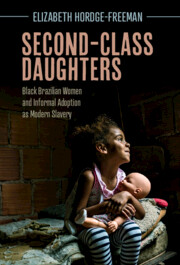Book contents
- Second-Class Daughters
- Afro-Latin America
- Second-Class Daughters
- Copyright page
- Dedication
- Contents
- Figure
- Acknowledgments
- Introduction
- 1 Adopting Modern Slavery
- 2 “Quase da Família” (Almost Family)
- 3 Prisoners of Love
- 4 Depths and Debts of Gratitude
- 5 Family Bonds and Bondage
- 6 Home Sick
- 7 Freedom to “Live Her Own Liberty”
- Conclusion
- Book part
- Works Cited
- Index
Introduction
“An Iron Chain around Your Soul”
Published online by Cambridge University Press: 10 March 2022
- Second-Class Daughters
- Afro-Latin America
- Second-Class Daughters
- Copyright page
- Dedication
- Contents
- Figure
- Acknowledgments
- Introduction
- 1 Adopting Modern Slavery
- 2 “Quase da Família” (Almost Family)
- 3 Prisoners of Love
- 4 Depths and Debts of Gratitude
- 5 Family Bonds and Bondage
- 6 Home Sick
- 7 Freedom to “Live Her Own Liberty”
- Conclusion
- Book part
- Works Cited
- Index
Summary
The book begins with a reference to a chilling ad placed in the local newspaper by a couple in Brazil looking to “adopt” a girl” to provide unpaid domestic labor. The author exposes how the rhetoric of family is used to facilitate labor exploitation of children and establishes the normalization of this practice in contemporary Brazil. Moving from the “circulation of children” to the exploitation of adult filhas de criação, Hordge-Freeman explains how racial, gender, and class domination shape the historical backdrop for the emergence of exploitative work–family relationships. Grounding this work, she introduces the theoretical concept of “affective captivity” as a framework that allows her to elaborate on the structural and affective factors involved with exploitative forms of informal adoption (criação). She notes the distinctiveness of her methodology, which includes longitudinal interviews (conducted over ten years) and the unique perspective of ethnographic observations of her live-in experiences with filhas de criação. Hordge-Freeman emphasizes the importance of an intersectional approach to contextualize the ambiguities between work and family in a way that leads to the enduring nature of these exploitative relationships.
- Type
- Chapter
- Information
- Second-Class DaughtersBlack Brazilian Women and Informal Adoption as Modern Slavery, pp. 1 - 35Publisher: Cambridge University PressPrint publication year: 2022

